ESP RENAULT SCENIC 2007 J84 / 2.G Automatic Transmission Siemens TA2005 Workshop Manual
[x] Cancel search | Manufacturer: RENAULT, Model Year: 2007, Model line: SCENIC, Model: RENAULT SCENIC 2007 J84 / 2.GPages: 139, PDF Size: 0.43 MB
Page 3 of 139
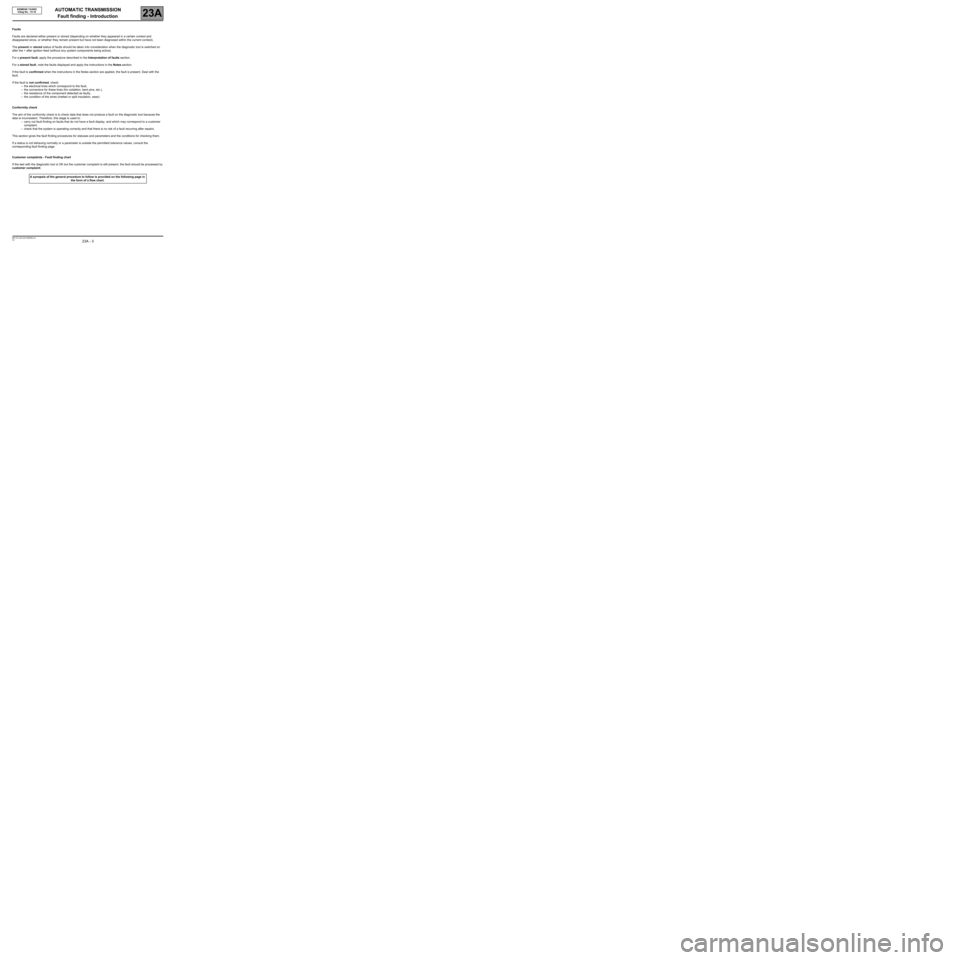
AUTOMATIC TRANSMISSION
Fault finding - Introduction
23A
23A - 3V5 MR-372-J84-23A100$058.mif
SIEMENS TA2005
Vdiag No.: 14-18
Faults
Faults are declared either present or stored (depending on whether they appeared in a certain context and
disappeared since, or whether they remain present but have not been diagnosed within the current context).
The present or stored status of faults should be taken into consideration when the diagnostic tool is switched on
after the + after ignition feed (without any system components being active).
For a present fault, apply the procedure described in the Interpretation of faults section.
For a stored fault, note the faults displayed and apply the instructions in the Notes section.
If the fault is confirmed when the instructions in the Notes section are applied, the fault is present. Deal with the
fault.
If the fault is not confirmed, check:
–the electrical lines which correspond to the fault,
–the connectors for these lines (for oxidation, bent pins, etc.),
–the resistance of the component detected as faulty,
–the condition of the wires (melted or split insulation, wear).
Conformity check
The aim of the conformity check is to check data that does not produce a fault on the diagnostic tool because the
data is inconsistent. Therefore, this stage is used to:
–carry out fault finding on faults that do not have a fault display, and which may correspond to a customer
complaint,
–check that the system is operating correctly and that there is no risk of a fault recurring after repairs.
This section gives the fault finding procedures for statuses and parameters and the conditions for checking them.
If a status is not behaving normally or a parameter is outside the permitted tolerance values, consult the
corresponding fault finding page.
Customer complaints - Fault finding chart
If the test with the diagnostic tool is OK but the customer complaint is still present, the fault should be processed by
customer complaint.
A synopsis of the general procedure to follow is provided on the following page in
the form of a flow chart.
Page 5 of 139
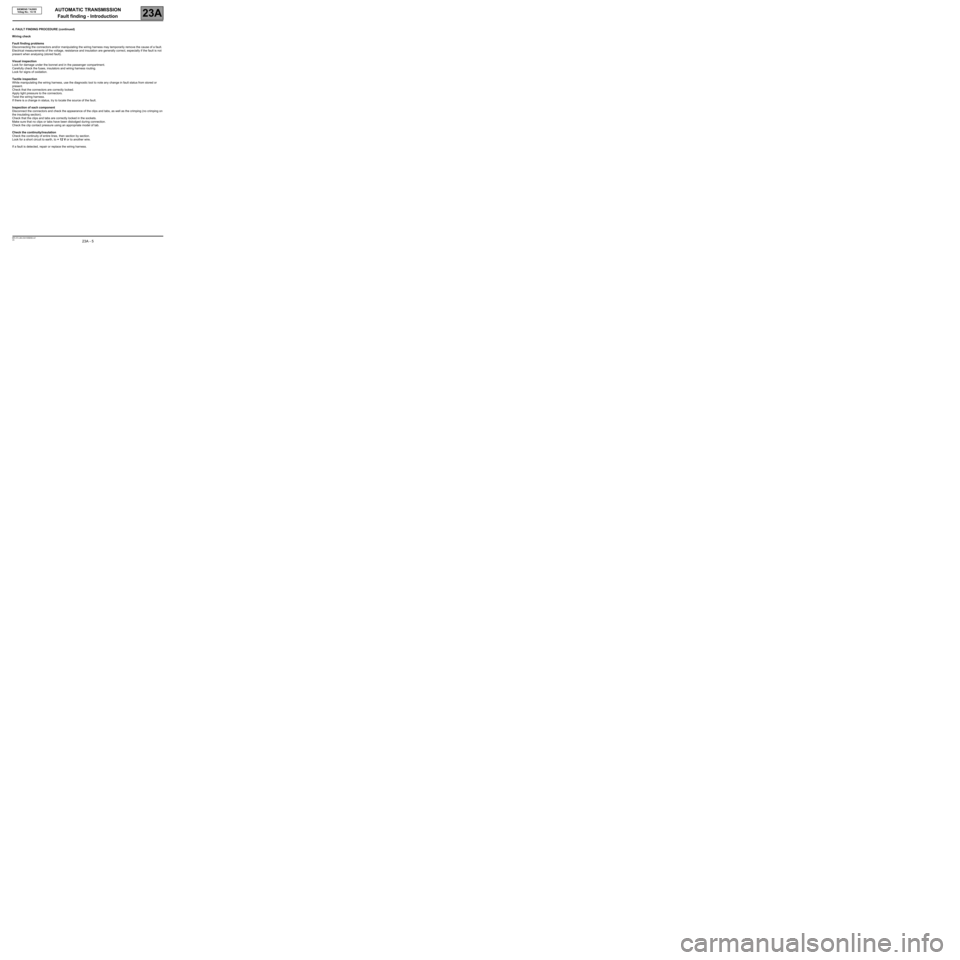
AUTOMATIC TRANSMISSION
Fault finding - Introduction
23A
23A - 5V5 MR-372-J84-23A100$058.mif
SIEMENS TA2005
Vdiag No.: 14-18
4. FAULT FINDING PROCEDURE (continued)
Wiring check
Fault finding problems
Disconnecting the connectors and/or manipulating the wiring harness may temporarily remove the cause of a fault.
Electrical measurements of the voltage, resistance and insulation are generally correct, especially if the fault is not
present when analysing (stored fault).
Visual inspection
Look for damage under the bonnet and in the passenger compartment.
Carefully check the fuses, insulators and wiring harness routing.
Look for signs of oxidation.
Tactile inspection
While manipulating the wiring harness, use the diagnostic tool to note any change in fault status from stored or
present.
Check that the connectors are correctly locked.
Apply light pressure to the connectors.
Twist the wiring harness.
If there is a change in status, try to locate the source of the fault.
Inspection of each component
Disconnect the connectors and check the appearance of the clips and tabs, as well as the crimping (no crimping on
the insulating section).
Check that the clips and tabs are correctly locked in the sockets.
Make sure that no clips or tabs have been dislodged during connection.
Check the clip contact pressure using an appropriate model of tab.
Check the continuity/insulation
Check the continuity of entire lines, then section by section.
Look for a short circuit to earth, to + 12 V or to another wire.
If a fault is detected, repair or replace the wiring harness.
Page 15 of 139
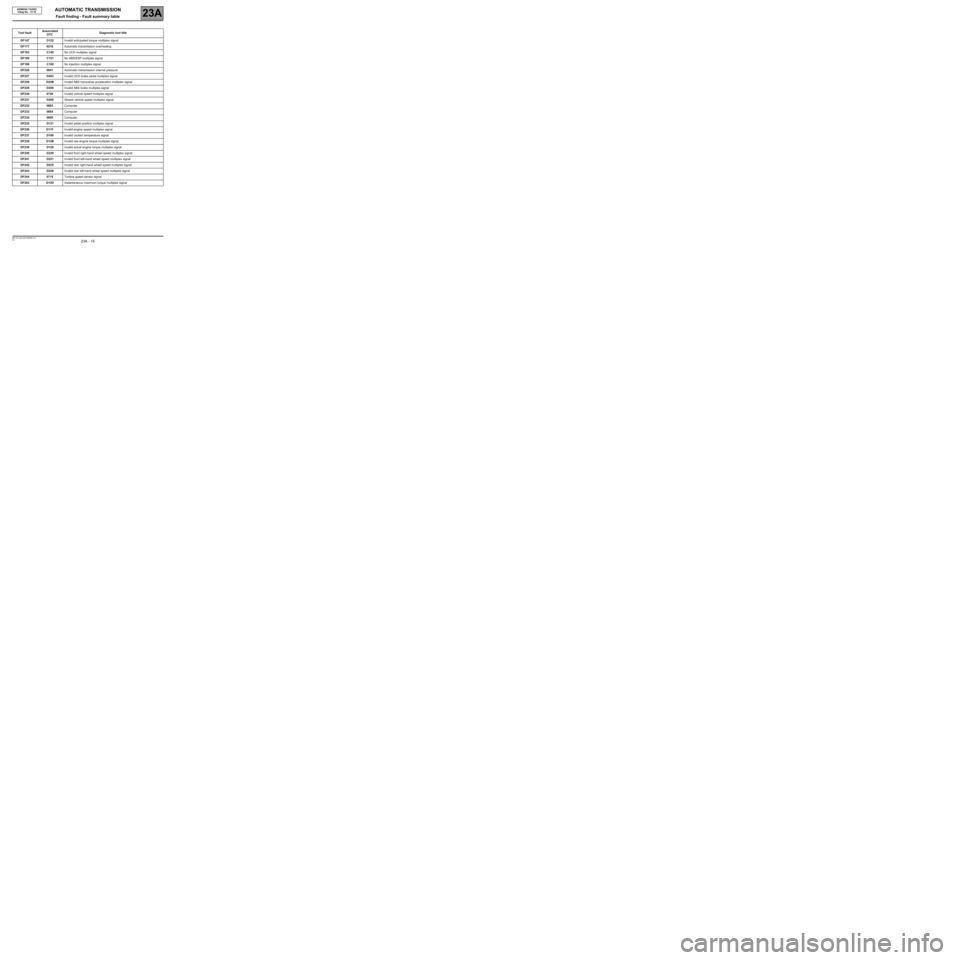
AUTOMATIC TRANSMISSION
Fault finding - Fault summary table23A
23A - 15V5 MR-372-J84-23A100$290.mif
SIEMENS TA2005
Vdiag No.: 14-18
Tool faultAssociated
DTCDiagnostic tool title
DF147 D122Invalid anticipated torque multiplex signal
DF177 0218Automatic transmission overheating
DF183 C140No UCH multiplex signal
DF185 C121No ABS/ESP multiplex signal
DF186 C100No injection multiplex signal
DF226 0841Automatic transmission internal pressure
DF227 D403Invalid UCH brake pedal multiplex signal
DF228 D22BInvalid ABS transverse acceleration multiplex signal
DF229 D208Invalid ABS brake multiplex signal
DF230 0720Invalid vehicle speed multiplex signal
DF231 D200Absent vehicle speed multiplex signal
DF232 0603Computer
DF233 0604Computer
DF234 0605Computer
DF235 D121Invalid pedal position multiplex signal
DF236 D11FInvalid engine speed multiplex signal
DF237 D100Invalid coolant temperature signal
DF238 D12BInvalid raw engine torque multiplex signal
DF239 D120Invalid actual engine torque multiplex signal
DF240 D220Invalid front right-hand wheel speed multiplex signal
DF241 D221Invalid front left-hand wheel speed multiplex signal
DF242 D225Invalid rear right-hand wheel speed multiplex signal
DF243 D226Invalid rear left-hand wheel speed multiplex signal
DF244 0715Turbine speed sensor signal
DF263 D12DInstantaneous maximum torque multiplex signal
Page 50 of 139
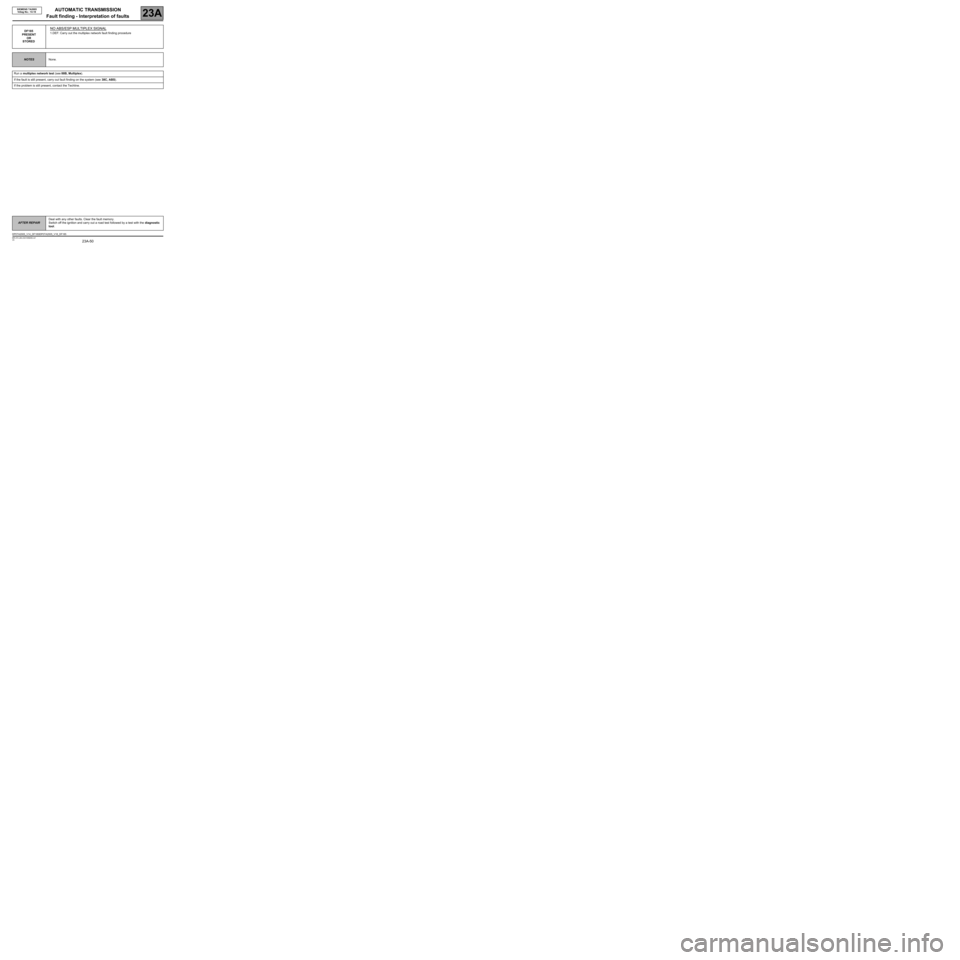
AUTOMATIC TRANSMISSION
Fault finding - Interpretation of faults
23A
23A-50V5 MR-372-J84-23A100$406.mif
SIEMENS TA2005
Vdiag No.: 14-18
DF185
PRESENT
OR
STOREDNO ABS/ESP MULTIPLEX SIGNAL
1.DEF: Carry out the multiplex network fault finding procedure
NOTESNone.
Run a multiplex network test (see 88B, Multiplex).
If the fault is still present, carry out fault finding on the system (see 38C, ABS).
If the problem is still present, contact the Techline.
AFTER REPAIRDeal with any other faults. Clear the fault memory.
Switch off the ignition and carry out a road test followed by a test with the diagnostic
tool.
DP0TA2005_V14_DF185/DP0TA2005_V18_DF185
Page 131 of 139
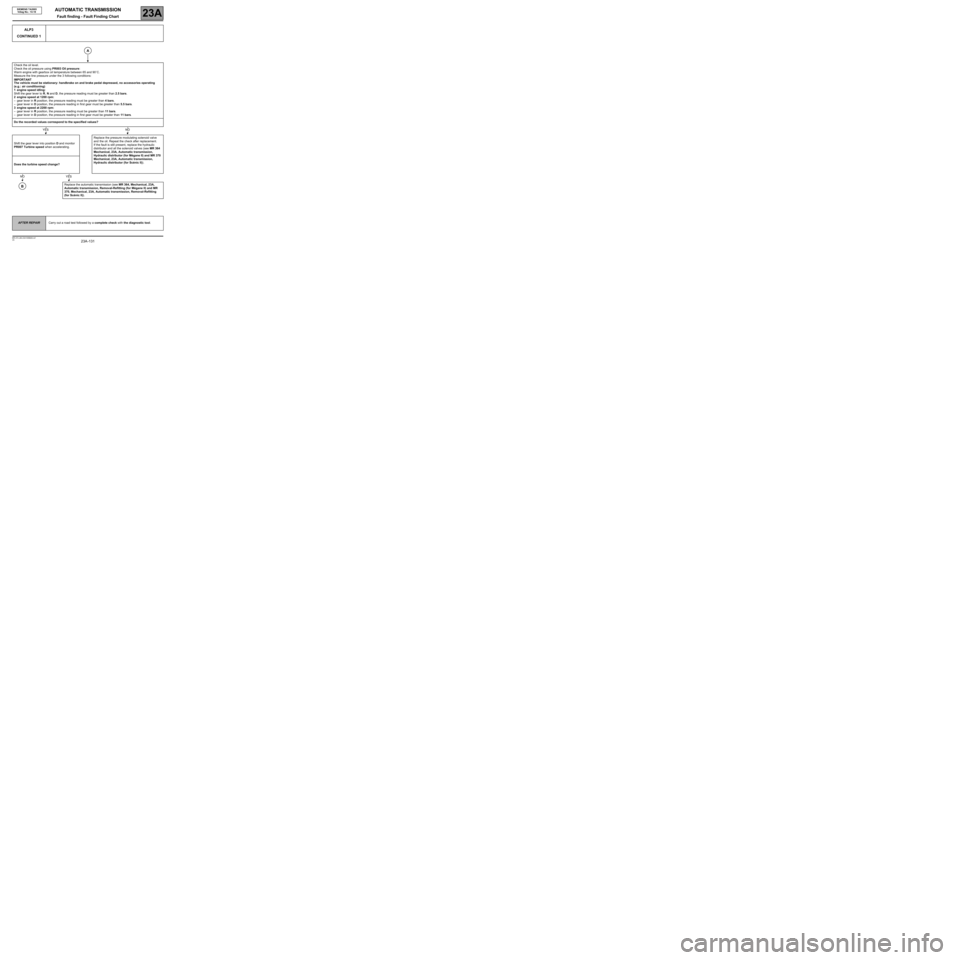
AUTOMATIC TRANSMISSION
Fault finding - Fault Finding Chart23A
23A -131V5 MR-372-J84-23A100$928.mif
SIEMENS TA2005
Vdiag No.: 14-18
ALP3
CONTINUED 1
Check the oil level.
Check the oil pressure using PR003 Oil pressure:
Warm engine with gearbox oil temperature between 65 and 90˚C.
Measure the line pressure under the 3 following conditions:
IMPORTANT
The vehicle must be stationary: handbrake on and brake pedal depressed, no accessories operating
(e.g.: air conditioning)
1engine speed idling:
Shift the gear lever to R, N and D, the pressure reading must be greater than 2.5 bars.
2engine speed at 1200 rpm:
–gear lever in R position, the pressure reading must be greater than 4 bars.
–gear lever in D position, the pressure reading in first gear must be greater than 5.5 bars.
3engine speed at 2200 rpm:
–gear lever in R position, the pressure reading must be greater than 11 bars.
–gear lever in D position, the pressure reading in first gear must be greater than 11 bars.
Do the recorded values correspond to the specified values?
Shift the gear lever into position D and monitor
PR007 Turbine speed when accelerating.Replace the pressure modulating solenoid valve
and the oil. Repeat the check after replacement.
If the fault is still present, replace the hydraulic
distributor and all the solenoid valves (see MR 364
Mechanical, 23A, Automatic transmission,
Hydraulic distributor (for Mégane II) and MR 370
Mechanical, 23A, Automatic transmission,
Hydraulic distributor (for Scénic II)).
Does the turbine speed change?
Replace the automatic transmission (see MR 364, Mechanical, 23A,
Automatic transmission, Removal-Refitting (for Mégane II) and MR
370, Mechanical, 23A, Automatic transmission, Removal-Refitting
(for Scénic II)).
A
YESNO
NOYES
B
AFTER REPAIRCarry out a road test followed by a complete check with the diagnostic tool.